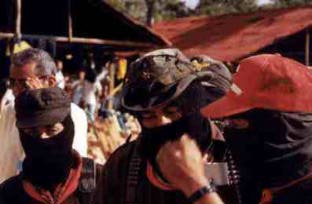|
|
|
|
|
|
|
|
|
|
I. Background
A. Chiapas
B. Maya
C. Economic Conditions
D. Governmental Actions
E. Protest Groups and Attempted Reforms
II. The Roles of Men, Women, and Children Within the Zapatista
Social Movement
A. Men
1. Men are divided into two main groups
2. Men make up the majority of rebel soldiers and of the community councils
that work closely with revolutionary
leaders.
B. Women
1. Women are divided into two main groups
2. Women work directly with the councils, not as soldiers but as community
leaders working with revolutionary leaders.
C. Children
1. Children are increasingly being raised in the midst of this social movement.
This new generation is involved in the
struggle. They help the soldiers, men and women who remain at home,
and the councils whenever possible. Often
they are virtually Zapatistas
III. Goals and Accomplishments of the Zapatistas
A. Societal Aims
B. Goals Achieved
1. A settlement was reached with the Mexican government.
2. Obtained laws guaranteeing the protection of the teaching and speaking
of the Maya language in schools and local
media.
C. Calls for Wide Scale
Land Reforms.
1. Chiapas is very rich agriculturally, but the Maya are consistently denied
access to the land.
D. Governmental Reforms
1. Calls for more local autonomy.
2. Calls for more democracy on the local and national level.
IV. Obstacles
A. Poverty and the
Mexican army in indigenous communities in Chiapas
B. Lack of Mexican
political support
C. Impact of new president-elect
D. The future
